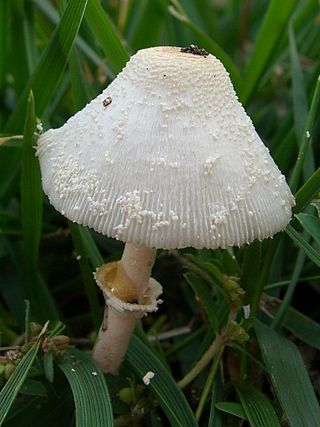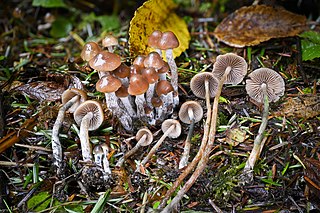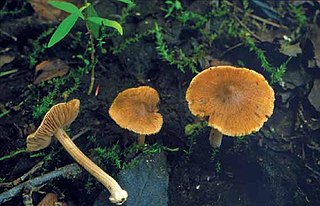
In mycology, a partial veil is a temporary structure of tissue found on the fruiting bodies of some basidiomycete fungi, typically agarics. Its role is to isolate and protect the developing spore-producing surface, represented by gills or tubes, found on the lower surface of the cap. A partial veil, in contrast to a universal veil, extends from the stem surface to the cap edge. The partial veil later disintegrates, once the fruiting body has matured and the spores are ready for dispersal. It might then give rise to a stem ring, or fragments attached to the stem or cap edge. In some mushrooms, both a partial veil and a universal veil may be present.

Hypholoma capnoides is a mushroom in the family Strophariaceae. Found in both the Old and New World, it grows on decaying wood and is edible, though may resemble some poisonous species.

Hypholoma fasciculare, commonly known as the sulphur tuft or clustered woodlover, is a common woodland mushroom, often in evidence when hardly any other mushrooms are to be found. This saprotrophic small gill fungus grows prolifically in large clumps on stumps, dead roots or rotting trunks of broadleaved trees.

Hypholoma lateritium, sometimes called brick cap, chestnut mushroom, cinnamon cap, brick top, red woodlover or kuritake, is a fungal species in the genus Hypholoma, which also contains the poisonous species Hypholoma fasciculare and the edible Hypholoma capnoides. Its fruiting bodies are generally larger than either of these. Hypholoma sublateritium is a synonym.

Psilocybe subaeruginosa is a species of agaric fungus in the family Hymenogastraceae described in 1927 and known from Australia and New Zealand. As a blueing member of the genus Psilocybe it contains the psychoactive compounds psilocin and psilocybin.

Leucocoprinus cepistipes, is a species of fungus in the family Agaricaceae. It is typically found on wood debris, such as wood chips but may also grow in potted plants or greenhouses. Typical characteristics include a fine-scaled bell-shaped cap, a partial veil, and a tendency to bruise a yellow to brown when handled.

Agaricus arorae is a moderate-sized, forest-dwelling mushroom that exhibits distinctive color changes. It fruits early in the mushroom season. Unusually within the genus Agaricus, the mushroom's cap cuticle turns yellow when exposed to a base such as potassium hydroxide or sodium hydroxide but stains red when cut. In the field, it has a brownish, fibrillose/squamulose cap, which turns red when bruised. Agaricus arorae was first described from Santa Cruz County but since has been found in San Mateo and Alameda counties. Agaricus arorae can be distinguished by its scales and a conspicuous stipe.

Aureoboletus mirabilis, commonly known as the admirable bolete, the bragger's bolete, and the velvet top, is an edible species of fungus in the Boletaceae mushroom family. The fruit body has several characteristics with which it may be identified: a dark reddish-brown cap; yellow to greenish-yellow pores on the undersurface of the cap; and a reddish-brown stem with long narrow reticulations. Aureoboletus mirabilis is found in coniferous forests along the Pacific Coast of North America, and in Asia. Unusual for boletes, A. mirabilis sometimes appears to fruit on the wood or woody debris of Hemlock trees, suggesting a saprobic lifestyle. Despite the occasional appearances to the contrary, Aureoboletus mirabilis is mycorrhizal, and forms a close association with the tree's roots.

Amanita nothofagi is a species of fungus in the family Amanitaceae. Endemic to New Zealand, the species was first described by mycologist Greta Stevenson in 1962. The fruit bodies have dark brown caps that are up to 13 cm (5.1 in) in diameter and covered with patches of soft greyish-brown scales or warts. The gills underneath the cap are crowded together, free from attachment to the stem, and white, becoming tinged with yellow in age. The stem of the mushroom is 4–14 cm (1.6–5.5 in) long by 0.5–2.5 cm (0.2–1.0 in) thick, and has a ring. The spore print is white, and individual spores are spherical to ellipsoid, measuring 7.5–9 by 7.5–9 micrometres. The mushroom may be confused with another New Zealand species, A. australis, but can be distinguished by certain characteristics. Amanita nothofagi is a mycorrhizal species, and grows in association with native New Zealand trees such as Southern Beech.

Suillus pungens, commonly known as the pungent slippery jack or the pungent suillus, is a species of fungus in the genus Suillus. The fruit bodies of the fungus have slimy convex caps up to 14 cm (5.5 in) wide. The mushroom is characterized by the very distinct color changes that occur in the cap throughout development. Typically, the young cap is whitish, later becoming grayish-olive to reddish-brown or a mottled combination of these colors. The mushroom has a dotted stem (stipe) up to 7 cm (2.8 in) long, and 2 cm (0.8 in) thick. On the underside on the cap is the spore-bearing tissue consisting of minute vertically arranged tubes that appear as a surface of angular, yellowish pores. The presence of milky droplets on the pore surface of young individuals, especially in humid environments, is a characteristic feature of this species. S. pungens can usually be distinguished from other similar Suillus species by differences in distribution, odor and taste. The mushroom is considered edible, but not highly regarded.

Lepiota clypeolaria, commonly known as the shield dapperling or the shaggy-stalked Lepiota, is a common mushroom in the genus Lepiota. It is widely distributed in northern temperate zones, where it grows in deciduous and coniferous forest. Fruit bodies have a brownish cap, a shaggy stipe with a collapsed, sheathing ring or ring zone, and spindle-shaped spores.

Amanita atkinsoniana, also known as the Atkinson's amanita, is a species of fungus in the family Amanitaceae. The fruit body is white to brownish, with caps up to 12.5 centimetres in diameter, and stems up to 20 cm long. The surface of the cap is covered with brownish conical warts.

Psilocybe pelliculosa is a species of fungus in the family Hymenogastraceae. The fruit bodies, or mushrooms, have a conical brownish cap up to 2 cm in diameter atop a slender stem up to 8 cm long. It has a white partial veil that does not leave a ring on the stem. American mycologist Alexander H. Smith first described the species in 1937 as a member of the genus known today as Psathyrella; it was transferred to Psilocybe by Rolf Singer in 1958.

Amanita crocea, the saffron ringless amanita, is a species of Amanita widely distributed in Europe. It is not recommended for consumption due to its similarity to poisonous species of the genus.

Gymnopilus maritimus is a fungus species of the family Hymenogastraceae first collected in northern Sardinia, Italy, in 2006. The species produces moderately sized, sturdy mushrooms of a reddish-orange colour. The cap, which can measure up to 70 millimetres (3 in) across, is covered in orange fibrils, and sometimes has small scales. The yellowish stem measures up to 110 mm (4 in) in length by 8 mm (0.3 in) in width, and sometimes shows remnants of the partial veil. The mushrooms have thick gills of a variable colour, ranging from yellow to rust but staining darker, and the yellow flesh has a mild taste. The mushrooms leave a rusty-brown spore print, while the spores themselves measure from 7.5–11.5 micrometres (0.00030–0.00045 in) in length. The species is most similar in appearance to G. arenophilus and G. fulgens, but can be differentiated from both morphologically. Despite the similarities, it is not closely related to either, suggesting convergent evolution. Instead, within the genus Gymnopilus, it is most closely related to the spectabilis–imperialis clade. However, it is not particularly similar to any of its closest relatives.

Cortinarius vanduzerensis is a species of mushroom in the family Cortinariaceae. Described as new to science in 1972, it is known only from the Pacific Northwest region of North America, where it grows under conifers such as spruce, hemlock, and Douglas-fir. The fruit bodies of the fungus, or mushrooms, have a slimy dark chestnut-brown cap that becomes deeply radially grooved or corrugated in maturity, and reaches diameters of up to 8 cm. The gills on the underside of the cap are initially pinkish-buff before becoming pale brown when the spores mature. The stem is lavender, measuring 10–18 cm (4–7 in) long and 1–2 cm thick. The mushroom produces a rusty-brown spore print, with individual spores measuring 12–14 by 7–8 micrometers. The edibility of the mushroom has not been determined, and it has been described as "much too slippery to be of value".
Cortinarius badiolaevis is a fungus in the family Cortinariaceae. The species produces mushrooms with smooth, red-brown caps up to 5 centimetres (2.0 in) in diameter, after which it is named. It has a white stem, and yellow-brown gills. It was first described in 2011, based on specimens collected in the 1990s and 2000s. C. badiolaevis is part of the subgenus Telamonia, but is not part of any known section, and does not have any close relatives within the genus. The rare species is known from Sweden and Spain, where it grows from soil in coniferous woodland.

Inocybe saliceticola is a fungus found in moist habitats in the Nordic countries. The species produces brown mushrooms with caps of varying shapes up to 40 millimetres (1.6 in) across, and tall, thin stems up to 62 mm (2.4 in) long. At the base of the stem is a large and well-defined "bulb". The species produces unusually shaped, irregular spores, each with a few thick protrusions. This feature helps differentiate it from other species that would otherwise be similar in appearance and habit.

Stropharia caerulea, commonly known as the blue roundhead, is a species of mushroom forming fungus in the family Strophariaceae. It is a somewhat common species found in Europe and North America, where it grows as a saprophyte in meadows, roadsides, hedgerows, gardens, and woodchip mulch. S. caerulea was officially described to science in 1979, although it was known to be a distinct species for about two centuries before that. The scientific name Stropharia cyanea, as defined by Tuomikoski in 1953, and used by several later authors, is a synonym of S. caerulea.

Gymnopus fusipes is a parasitic species of gilled mushroom which is quite common in Europe and often grows in large clumps. It is variable but easy to recognize because the stipe soon becomes distinctively tough, bloated and ridged.
























